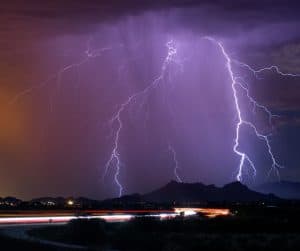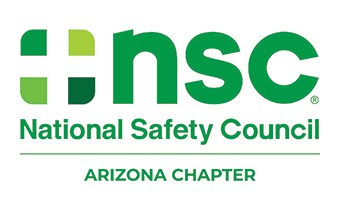
If you do business in the Southwest, you know that when monsoon season rolls in, things can get tricky. Fast.
One moment, skies are clear. The next, your team could be navigating blinding dust, sudden downpours, or road-closing floods. These fast-moving storms can create serious hazards for employees who drive as part of their job or work outdoors. Understanding what to expect — and how to respond — is critical for keeping your workforce safe.
When Is Monsoon Season?
Monsoon season in Arizona, New Mexico, and southern Nevada runs from June 15 to September 30. It begins with a shift in wind patterns that pulls moisture from the Gulf of Mexico and Pacific Ocean into the region, setting the stage for intense weather.
In Arizona, storms typically begin in late June or early July, with the most active period occurring in July and August. New Mexico sees a similar timeline. In Nevada, the southern part of the state — particularly around Las Vegas — is most affected. While activity there may start as early as mid-June, the strongest storms usually arrive by early July.
On the road, these storms can create fast-changing and hazardous driving conditions. Short bursts of heavy rain can flood low-lying areas and arroyos (washes), while strong monsoon winds – between 40 and 60 mph, according to the National Weather Service – may dislodge debris or create intense dust storms (haboobs) that reduce visibility to near zero. Hail and lightning also increase the risk to drivers and vehicles.
Driving Tips to Stay Safe
No matter how experienced your drivers are, monsoon conditions demand caution. Share these safety tips with your team:
Dust Storms
-
- Don’t drive into a dust storm. Pull off the road completely, turn off your lights, set the parking brake, and keep your foot off the brake pedal. If other drivers see your brake lights, they may assume you’re still on the road and follow you — potentially causing a collision.
- Stay inside the vehicle with your seatbelt buckled until the storm passes.
Heavy Rain & Flooding
-
- Never cross a flooded wash or roadway — even if it doesn’t look deep. Just a few inches of moving water can sweep away a vehicle. Washes (called arroyos in New Mexico) can flood quickly and without warning.
- Avoid areas where water is pooling in travel lanes. If possible, use center lanes and follow the tire tracks of the vehicle ahead of you.
- Do not drive around “Road Closed” signs or barricades. It’s not only dangerous but could lead to costly rescues. In Arizona, you could be cited under the state’s Stupid Motorist law.
- Storm runoff can loosen rocks and boulders on hillsides. Be alert for debris or falling rocks, especially in mountainous or sloped areas.
- If traffic signals are out, treat the intersection as a four-way stop.
General Driving
-
- Reduce speed and increase following distance to allow for more reaction time.
- Avoid sudden braking. Instead, ease off the gas and brake slowly to avoid sliding on wet pavement.
- Be cautious of hydroplaning — when water between your tires and the road causes a loss of traction. If your vehicle starts to slide or drift, ease off the gas, don’t brake suddenly, and gently steer in the direction of the slide until you regain control.
- Don’t follow large vehicles too closely. Their tires can kick up water spray that reduces your visibility.
- Turn on headlights during rain or low-visibility conditions to help other drivers see you.
- Before the season starts, inspect windshield wipers and replace them if needed.
- Keep an emergency kit in your vehicle with water, snacks, a flashlight, a phone charger, and a fully charged cell phone.
- Expect the unexpected. If conditions look dangerous ahead — a dust storm, heavy rain, or flooded area — exit the roadway and wait it out from a safe location.
In the Southwest, monsoon season is a fact of life – but accidents and serious injuries and accidents don’t have to be. With the right planning, awareness, and response, you can keep your team safe on the road and on the job.
For more resources and workplace safety training, visit www.acnsc.org/courses.
